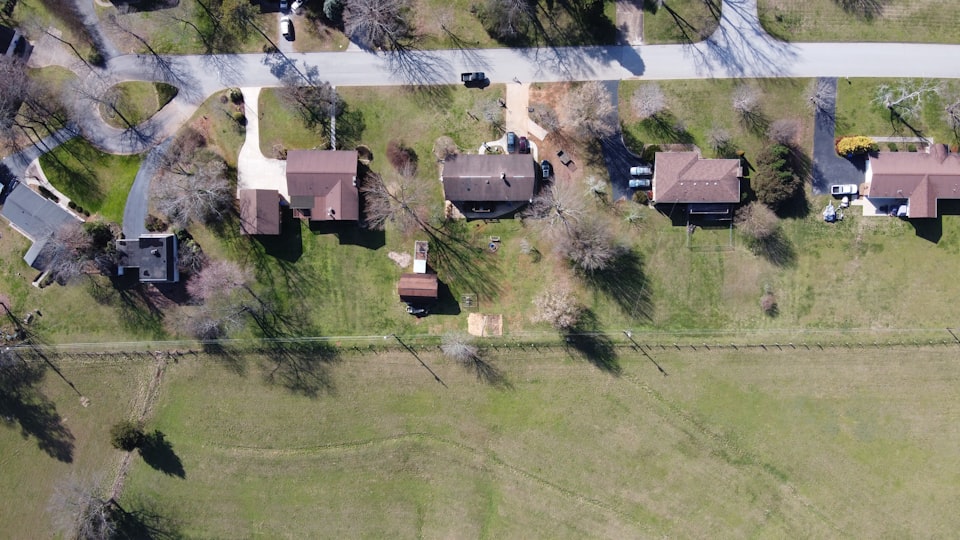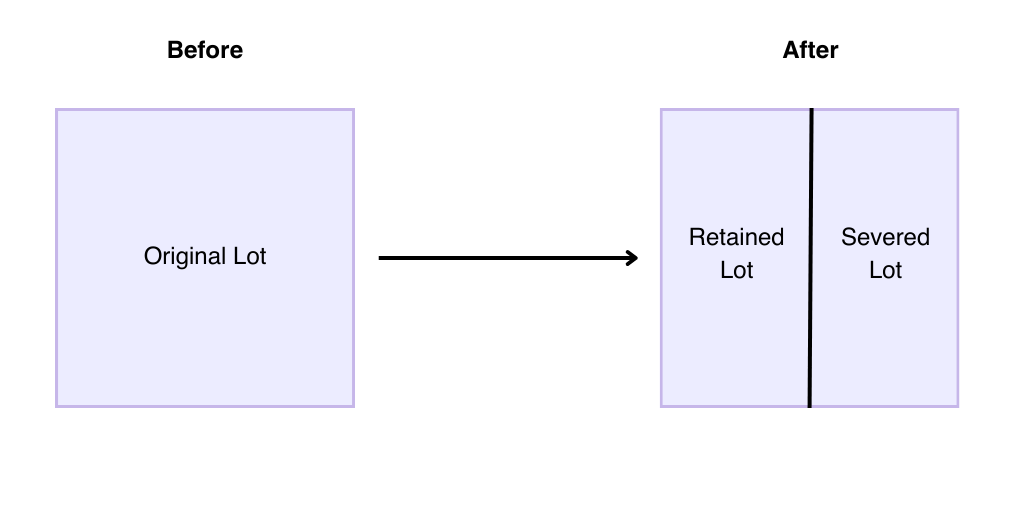Land Severance in Ontario: The Complete Guide

At this time, we are not accepting new files for this type of matter.
What is a Land Severance?
A land severance is the division of land for the purpose of creating a new lot. In other words, its turning one piece of land into two (2) or more. In Ontario, you need the local municipality's permission to do this.
Below is an example of what a land severance looks like. The newly created lot is called the severed lot, and the remainder of the original lot is called the retained lot.

Land severance benefits both the property owner and the municipality. The property owner benefits from ability to sell, mortgage, or develop a portion of their land. This is often financially lucrative.
The local municipality benefits from organized urban development and an increase in the municipality's tax base by creating new housing. They can ensure that development aligns with local planning goals through their approval process.
The Land Severance Process
The land severance process is challenging. It requires an understanding of the municipal process, complex legislation, and land use planning principles. In Ontario, the primary legislation governing land severance is the Planning Act.
Land severance approvals are decided on by the municipality's "consent-granting authority" (CGA). This is either the municipal council or the Committee of Adjustment (a group of individuals, appointed by council, for the purpose of expediting these types of decisions).
Here's what this process looks like:

Pre-Application Consultation
This first step in the land severance process is a consultation with the municipality. The purpose of this is to evaluate the merits of the application and identify potential problems that may need to be addressed.
This consultation will involve various departments from the municipality such as Planning, Engineering, Building, Fire, Public Works, etc. These consultations are performed in-person, remotely, or in written form.
A Pre-Application Consultation will also determine whether any supporting materials are required to be submitted along with the application such as a Special Report or a Minor Variance Application.
Application Submission
The applicant will then prepare the formal application paperwork and submit this to the municipality along with the application fees and any supporting materials required.
Once the application is received by the city, the Planning Act requires public notice of the application at least 14 days prior to a decision. This is done by way of a letter mailed to every land owner within 60 metres of the subject land and the posting of a notice on the subject land.
Any member of the public may provide written notice to the municipality to receive updates on the application and decision.
Recommendation Report
In the time leading up to the decision, the municipality's planning staff prepares a Recommendation Report. The report includes an overview of the application, internal and public comments, a planning analysis for the land severance, and a recommendation on the decision.
The purpose of the report is to explain the technical aspects of land use planning to the municipality. While the report's recommendation is highly influential, the CGA is not bound to follow it.
Public Meeting
The public meeting is the "main event" in a land severance application. A typical meeting starts with a summary of the Recommendation Report. This is followed by the applicant (or their representative) providing context to the application, arguing for its merits, and responding to any concerns. The floor is then opened to the public for comments on the application, with the applicant being given a final chance to respond.
Once everyone has had a chance to speak, the CGA deliberates and asks questions in real time. They then take a vote on whether the application should be approved.
Evaluating and Appealing Decisions
The CGA has the authority to approve an application (with or without conditions) or refuse it. If the applicant is not satisfied with the decision, they have an option to appeal.
Evaluation Criteria
In making their decision, the CGA considers the following criteria:
- conformity with the official plan and compatibility with neighbouring uses of land,
- suitability of the land for the proposed purpose, including the size and shape of the lot(s) being created,
- adequacy of vehicular access, water supply, sewage disposal,
- the need to ensure protection from potential flooding.
While there is no defined legal test, the decision must ultimately be consistent with the Provincial Policy Statement (PPS) and applicable provincial plans.
Appeal Process
If the decision is unfavorable, an applicant can appeal to the Ontario Land Tribunal (OLT) or the Toronto Local Appeal Body (TLAB) - depending on jurisdiction - within 20 days.

The appeal hearing is more formal than the public meeting. Each party is represented by a lawyer and the rules of evidence are more defined. Hearings last between 1-5 days, depending on the complexity of the issues.
Costs and Financials
There are several financial implications associated with a land severance application, including survey costs, application fees, special reports, and professional fees.

Survey Costs
Before a Land Severance Application can be submitted, a detailed survey of the property is required. This involves hiring a registered surveyor to accurately map out the land, its dimensions, boundaries, and any notable physical features. A survey costs approximately $3,000 for a typical residential property.
Application Fees
These are the fees paid to the municipality for processing the application. Each municipality sets their own rate. In 2024, the City of Toronto Application Fee was $6,763.20. Smaller municipalities usually have lower fees.
Special Reports
The municipality has the right to request one or more special reports be submitted with an application. These can be environmental impact assessments, traffic studies, planning justification reports, etc. Special Reports are approximately $3,000 to $5,000 each. This figure can be higher depending on the type of report.
Professional Fees
These are fees for any professionals hired to assist with the application, such as a lawyer or planning consultant. Most charge hourly for their knowledge and expertise. Professional fees can be $300 to $800 per hour for a lawyer and $150 to $500 per hour for a planner.
Expert Guidance
An applicant is not required to hire a lawyer during the land severance process. However, an experienced legal representative can be a real asset. Here are few ways a lawyer can help:
- Preparing the Application: With knowledge of the paperwork and process, a lawyer can optimize your application to increase its chances of success. They also ensure it meets all legislative requirements to avoid costly errors and delays.
- Representing your Interests: A lawyer can appear in your place during the Pre-Application Consultation and the Public Meeting. This ensures that your application is vigorously advocated for and provides an expert voice to navigate complex issues.
- Mitigating Risks: By identifying and addressing potential legal issues early, a lawyer can help mitigate any risks that may arise during the application process or a potential appeal.
- Negotiating Conditions: If the municipality imposes conditions on your application's approval, a lawyer can assist in negotiating more favorable terms.
While there's an upfront cost in hiring a lawyer, their expertise can increase your chances of success, potentially saving you time and money in the long run, and making the entire process more seamless and less stressful.
Summary
Land severance in Ontario is complex and time-consuming. A successful application must navigate the intertwining disciplines of law, conform to legislation, and appreciate the local political landscape. Despite the challenges, with the right representation, a land severance can be a financially rewarding endeavor.
Frequently Asked Questions (FAQ)
What is required to sever land in Ontario?
At minimum, you will need a survey of your property and a completed Land Severance Application from the municipality.
What are the rules for land severance in Ontario?
A land severance is required if an individual wants to sell, mortgage, or develop a portion of their land. Approval is needed from the local municipality.
How much does it cost to sever land in Toronto?
The total cost of a Land Severance Application in Toronto is between $10,000 and $50,000.
What is the difference between land severance and subdivision?
A land severance is generally used for for the creation of one (1) to three (3) new lots. When creating more than three (3) new lots, a plan of subdivision may be required. It's up to the consent-granting authority to decide.
What is the Ontario Land Tribunal?
The Ontario Land Tribunal (OLT) adjudicates matters involving land use planning, environmental and heritage protection, land valuation, land compensation, and related matters.
